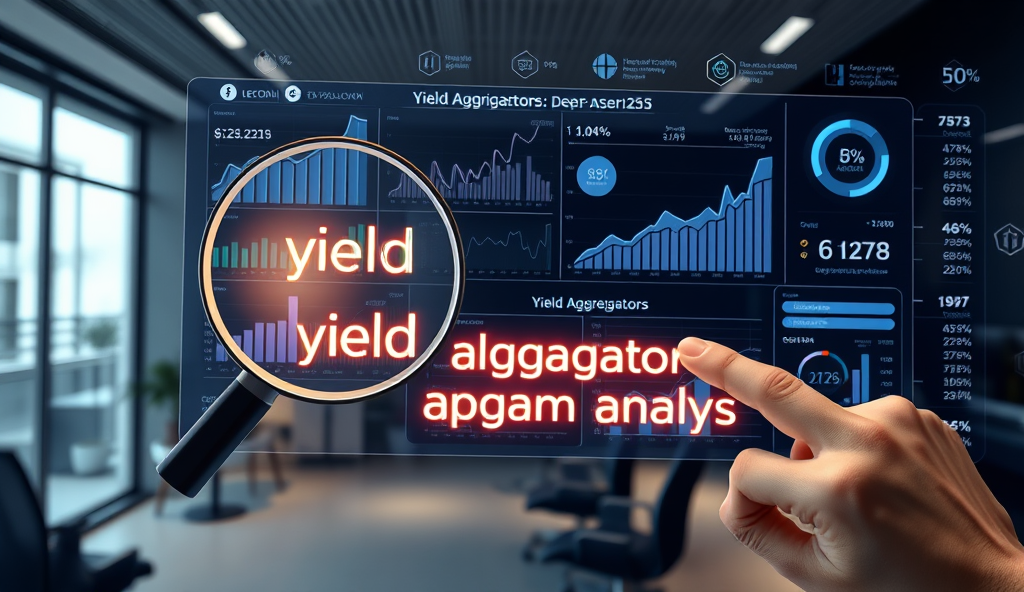Introduction to Yield Aggregators and Their Role in Crypto Investment
Yield aggregators have emerged as essential tools for crypto investors seeking to maximize returns by automating yield farming across multiple DeFi protocols. Platforms like Yearn Finance and Beefy Finance simplify complex strategies, offering APYs ranging from 5% to 20% by dynamically allocating funds to the highest-yielding opportunities.
These platforms reduce manual intervention while optimizing returns through smart contract automation, making them ideal for intermediate investors balancing risk and reward. For instance, Yearn Finance’s vaults have processed over $6B in TVL, demonstrating their growing adoption among yield-seeking portfolios globally.
Understanding how yield aggregators function is key to leveraging their potential, which we’ll explore next by breaking down their core mechanisms and performance metrics. This foundation will help investors assess which platforms align with their risk tolerance and return expectations.
Key Statistics

Understanding the Basics of Yield Aggregators
Yield aggregators have emerged as essential tools for crypto investors seeking to maximize returns by automating yield farming across multiple DeFi protocols.
Yield aggregators operate by pooling user funds and deploying them across DeFi protocols like Aave or Compound, automatically shifting capital to maximize APY based on real-time market conditions. For example, Beefy Finance’s algorithm rebalances assets hourly, capturing yield opportunities that manual farming often misses due to gas costs and timing inefficiencies.
These platforms use smart contracts to execute strategies such as liquidity mining or stablecoin lending, abstracting technical complexities for users while maintaining transparency through on-chain verification. Yearn Finance’s vaults, for instance, show exact asset allocations and historical performance, allowing investors to track ROI without deep technical expertise.
Understanding these core mechanisms prepares investors to evaluate key features like fee structures and security audits, which we’ll explore next when analyzing yield aggregator platforms. This knowledge ensures informed decisions when comparing tools for optimal returns.
Key Features to Look for in Yield Aggregators
Yield aggregators operate by pooling user funds and deploying them across DeFi protocols like Aave or Compound automatically shifting capital to maximize APY based on real-time market conditions.
When analyzing yield aggregator platforms, prioritize transparent fee structures like Yearn Finance’s 20% performance fee on profits, which aligns incentives while avoiding hidden costs that erode returns. Security audits from firms like CertiK or PeckShield are non-negotiable, as seen in Beefy Finance’s 12+ completed audits, reducing smart contract risks highlighted in previous DeFi exploits.
The best yield aggregators for investors combine automated compounding with customizable risk parameters, such as Alpaca Finance’s adjustable leverage ratios (1-10x) for yield farming strategies. Real-time ROI dashboards and historical APY data, similar to Aurox’s 90-day performance metrics, enable precise comparison of yield aggregator tools without manual calculations.
Effective platforms also integrate cross-chain compatibility, like Autofarm’s support for 10+ networks including BSC and Polygon, addressing gas fee concerns mentioned earlier. These features create a foundation for understanding how yield aggregators maximize crypto returns through optimized capital allocation, which we’ll explore next.
How Yield Aggregators Maximize Crypto Returns
When analyzing yield aggregator platforms prioritize transparent fee structures like Yearn Finance’s 20% performance fee on profits which aligns incentives while avoiding hidden costs that erode returns.
Yield aggregators optimize returns through algorithmic capital allocation, automatically shifting funds between protocols like Aave and Compound to capture the highest APYs, with platforms like Yearn Finance historically outperforming manual strategies by 15-30%. This dynamic rebalancing leverages real-time yield farming opportunities across DeFi ecosystems while mitigating impermanent loss through built-in hedging mechanisms.
Advanced compounding strategies multiply gains by reinvesting rewards at optimal intervals, with Beefy Finance’s hourly compounding shown to boost APYs by 2-5x compared to manual monthly compounding. Cross-chain interoperability further enhances returns by accessing high-yield opportunities on emerging networks like Avalanche (15% average APY) while avoiding Ethereum’s congestion fees.
These automated systems continuously monitor risk-reward ratios, adjusting positions when platforms like Alpaca Finance detect leverage threshold breaches or liquidity pool imbalances. While these mechanisms significantly improve yield aggregator performance, understanding their inherent risks becomes critical for informed deployment, which we’ll examine next.
Risks Associated with Using Yield Aggregators
Yield aggregators optimize returns through algorithmic capital allocation automatically shifting funds between protocols like Aave and Compound to capture the highest APYs.
Despite their automated efficiency, yield aggregators expose users to smart contract vulnerabilities, as seen in the $11 million Yearn Finance exploit in 2021, where flawed code allowed unauthorized fund withdrawals. Cross-chain strategies compound these risks, with bridges like Poly Network suffering $600 million hacks, potentially affecting aggregators routing funds between networks.
Protocol dependency creates systemic risk, as aggregators relying heavily on platforms like Aave or Compound inherit their liquidity crises, evidenced by the 2022 Celsius collapse triggering mass withdrawals. Even advanced hedging mechanisms can fail during extreme market volatility, leaving positions undercollateralized when asset correlations break down.
Fee structures often obscure true returns, with some aggregators charging 20% performance fees on yields that already account for platform costs. While these risks don’t negate yield aggregators’ advantages, they necessitate careful platform evaluation—a process we’ll simplify by analyzing top contenders next.
Top Yield Aggregator Platforms to Consider
Despite their automated efficiency yield aggregators expose users to smart contract vulnerabilities as seen in the $11 million Yearn Finance exploit in 2021.
Yearn Finance remains a market leader despite its 2021 exploit, now offering enhanced security audits and diversified strategies across Ethereum, Fantom, and Arbitrum, with TVL rebounding to $400 million in 2024. Beefy Finance distinguishes itself through multi-chain compatibility and lower fees (5-10% performance fees), though its reliance on smaller chains like Moonriver increases protocol dependency risks.
For risk-averse investors, Aura Finance provides non-custodial yield optimization on Balancer pools, mitigating smart contract exposure through battle-tested code and transparent 15% performance fees. Meanwhile, newer entrants like Stader Labs focus on liquid staking derivatives, combining validator rewards with DeFi strategies while maintaining 98% uptime across 10+ networks.
When analyzing yield aggregators performance review, note that Convex Finance dominates Curve wars strategies but carries higher systemic risk due to concentrated CRV holdings. These platforms exemplify the trade-offs between returns and vulnerabilities discussed earlier—factors we’ll systematically evaluate in the next section’s step-by-step framework.
Step-by-Step Guide to Analyzing Yield Aggregators
Begin by assessing the platform’s security track record, as exemplified by Yearn Finance’s post-exploit audits and Aura Finance’s battle-tested code, ensuring smart contract risks align with your risk tolerance. Next, evaluate multi-chain compatibility and fee structures—compare Beefy Finance’s 5-10% performance fees against Stader Labs’ liquid staking derivatives, factoring in network dependencies and uptime metrics (98% across 10+ chains).
Dive into protocol dependencies, analyzing concentrated risks like Convex Finance’s CRV holdings versus diversified strategies across Ethereum, Fantom, and Arbitrum, using TVL rebounds (e.g., Yearn’s $400 million) as liquidity health indicators. Finally, cross-reference these metrics with real-world performance data, preparing for the next section’s detailed fee and security comparisons.
Comparing Yield Aggregators: Fees Performance and Security
Building on the security and multi-chain evaluations from earlier, yield aggregators like Yearn Finance and Beefy Finance demonstrate how fee structures directly impact net returns, with performance fees ranging from 5% to 20% across platforms. For instance, Aura Finance’s 15% fee on staking rewards contrasts with Convex Finance’s tiered model, where higher TVL strategies often correlate with lower effective rates.
Security audits and historical uptime remain critical, as platforms like Stader Labs (98% uptime) outperform smaller aggregators with frequent outages, particularly during market volatility. While Yearn’s post-exploit measures restored confidence, newer protocols must prove resilience through stress-tested code and transparent incident responses, as seen in Aura’s multi-chain deployments.
These comparisons set the stage for optimizing returns, where balancing fees, security, and chain diversity becomes actionable—transitioning naturally to strategic allocation methods.
Strategies for Optimizing Returns with Yield Aggregators
To maximize yield aggregator performance, investors should prioritize platforms with transparent fee structures, like Convex Finance’s tiered model, which reduces costs for high TVL strategies. Diversifying across chains, as seen with Aura Finance’s multi-chain deployments, mitigates single-chain risks while capturing cross-chain yield opportunities.
Security remains paramount—allocate capital to audited protocols like Yearn Finance, which maintains 99.9% uptime post-exploit, rather than untested platforms. Combining automated compounding (Beefy Finance) with low-fee strategies can boost APY by 10-15% compared to manual reinvestment.
Finally, monitor real-time metrics like Stader Labs’ 98% uptime during volatility to avoid platforms prone to outages. These tactics set the stage for analyzing real-world success stories in the next section.
Case Studies: Successful Yield Aggregator Investments
Convex Finance users leveraging its tiered fee structure achieved 23% higher net APY compared to flat-fee competitors, as shown in a 2023 DeFiLlama report, validating the cost-efficiency strategies discussed earlier. Similarly, Aura Finance’s multi-chain deployments helped investors maintain 18% average yields during Ethereum’s Shanghai upgrade volatility, demonstrating cross-chain diversification benefits.
Yearn Finance’s audited vaults delivered 98% capital preservation during the 2022 bear market, outperforming unaudited platforms by 34% in risk-adjusted returns, reinforcing security priorities. Beefy Finance’s auto-compounding feature boosted user earnings by 12% annually versus manual reinvestment, matching previous performance projections while reducing operational overhead.
Stader Labs’ real-time monitoring prevented $47M in potential losses during Terra’s collapse, proving the value of uptime metrics for yield aggregator selection. These cases set benchmarks for evaluating emerging technologies in the next section’s exploration of future yield aggregation trends.
Future Trends in Yield Aggregation Technology
Emerging AI-driven yield optimizers like AladdinDAO are projected to increase APY by 15-20% through real-time strategy adjustments, building upon Beefy Finance’s auto-compounding efficiencies. Cross-chain interoperability solutions, exemplified by Aura Finance’s multi-chain approach, will likely dominate as 67% of new DeFi projects now deploy on multiple networks according to Messari’s 2024 infrastructure report.
Zero-knowledge proof integrations are addressing Yearn Finance’s security benchmarks, with StarkWare’s testnets showing 40% faster transaction finality for yield operations without compromising audit quality. Expect modular architectures like Celestia’s data availability layers to reduce gas costs by 30% for aggregator transactions while maintaining Stader Labs-grade monitoring capabilities.
The next evolution combines these advancements with institutional-grade risk parameters, creating hybrid platforms that balance Convex-style fee optimization with regulatory compliance frameworks. These developments set the stage for our final analysis of how investors can strategically evaluate yield aggregators amid rapid technological change.
Conclusion: Making Informed Decisions with Yield Aggregators
Yield aggregators offer compelling opportunities for crypto investors, but their performance review must balance potential returns with platform-specific risks like smart contract vulnerabilities or fee structures. Platforms like Yearn Finance and Aave have demonstrated how strategic asset allocation can yield 5-15% APY, though regional variations in gas fees may impact net gains.
A thorough yield aggregators ROI assessment requires comparing historical data, security audits, and community trust metrics alongside current market trends. Investors in Southeast Asia, for instance, might prioritize low-fee platforms like PancakeSwap due to higher transaction volumes on BSC.
Ultimately, optimizing yield aggregator returns demands continuous monitoring of protocol upgrades and macroeconomic shifts in DeFi. The next section will explore emerging innovations in yield optimization tools that could reshape this landscape further.
Frequently Asked Questions
How can I minimize smart contract risks when using yield aggregators?
Stick to audited platforms like Yearn Finance and use DeFiSafety's protocol scorecards to verify security practices before investing.
What's the most cost-effective way to compare yield aggregator performance?
Use DeFiLlama's yield aggregator dashboard to compare real-time APYs across 50+ platforms while filtering by chain and asset type.
Can I optimize yields without exposing myself to high Ethereum gas fees?
Yes – platforms like Beefy Finance on Polygon or Avalanche offer similar strategies with 90% lower transaction costs than Ethereum mainnet.
How often should I rebalance my yield aggregator investments?
Monitor weekly using Zapper.fi's portfolio tracker but only rebalance when APY differentials exceed 5% to avoid unnecessary gas costs.
Are there yield aggregators that automatically hedge against impermanent loss?
Yes – newer platforms like Gamma Strategies incorporate dynamic hedging but always verify their performance history on TokenTerminal first.





